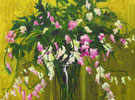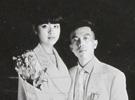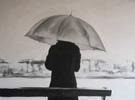20年前我和罗永进开始探究艺术家的工作室。1990年的四月,我们见了许多艺术家并拜访了他们的工作室或住所(或房间)。那时当代艺术的影响尚处于小范围,那些为之奉献的人挣扎于重重困难中——最大的困难便是如何用非传统非常规的方法创作艺术。当时罗永进正忙于拍摄一部记录片——我们想在了解艺术家生活的同时留下一些影像资料,这是项十分艰巨的任务。熟悉这些媒介的人都明白,拍录像与拍静物对构思的要求不同,但我们没有别的选择。
那时罗永进依然深受西方摄影大师的影响,比如卡蒂埃·布列松。他设法捕捉瞬间并聚焦于事物的刹那表现、活动及形态。他的主要拍摄对象为人物。当时几乎所有的作品都是肖像,尽管还不能呈现人物所表达的感觉,但不久罗永进就发展出一种安静隐秘的拍摄方式,使事物最自然的一面不受拍摄的干扰。
我已提及他的拍摄对象为人物——即艺术家。更为恰当地说,“工作室里的艺术家”。罗永进可以迅速了解一个人的性格,不仅通过观察他/她本人,更是通过观察其所处的环境。摄影师不擅言辞,不愿花太多时间在聊天上。他宁愿当一位杰出的观察家;用他锐的目光捕捉在一个地方,一处风景或一个表情的琐碎细节。他喜欢随意游动,不必去款待自己所在地的主人。我不知道这是一种羞怯还是刻意为之,人使让他忽略时间的流逝。我预感摄影师在处理“非人”对象时所享受的“宁静空间”最终会使像他这样性格的人往事实更深处前进而不受空谈和情绪的相互影响。
从“新民居·洛阳(1997)”开始,罗永进的作品不再以人为主要对象。然而,罗永进拍摄的所有物品都是人造的。每一幅作品叙述着人类“宏观世界”的一段故事(例如宏伟的城市风光或政府建筑物)或“微观世界”,就像这一新系列:“艺术家的所有物”。
大约两年年,当罗永进告诉我他想以艺术家工作室为题拍摄一组照片时,我觉得这想法很好,但几个月后我所看到的和我当时想的完全不同。我本以为他会140度旋转镜头相机拍下整个工作室环境。但当我看见作品时,我才意识到他用了放大透镜从而使阴影、水滴、尘埃等细小物体突显… … 这令我十分惊讶和感动。
就我所知,绝大多数艺术家的工作室都已被罗永进严密而柔情的眼睛“检验”过。我可以从一些物品的细节处了解主人的性格。尽管这只是我个人欣赏作品的感受。特别是当看到他在我家拍的照片时,我感到格外亲切——这些照片让我深知朋友对我的了解。
谈及和不了解艺术家的普通观众所能分享的感受,我再次保证他们没有错过任何相关之处。正如每一件精心“培育”的艺术品,这些图像包含了不同层次的理解。尽管每幅作品都有标识,比如空间主人的姓名,但这对于整件作品而言无足轻重。即使知道宋海东的花瓶底下有死苍蝇也毫无意义。感受这些“静止的生命”才是关键。重要的是摄影师捕捉画面的能力,甚至连空间的主人也忽略了这些诗意亲切又煽情的场景。他帮助艺术家和观众追寻日常环境中的美、情感及非凡的视点(色彩如抽象画般滴落,尘埃留下有趣的轨迹,不经端详的景色)。
我觉得从各方面看罗永进都是一位热爱生活的人,无论在哪里,他总能发现吸引他目光的事物。他总能通过眼睛和相机转化事物并使之改善我们的生活。他把平凡的事物提升到另一境界,从而鼓舞我们并满足我们对美、宁静及和平的渴望。
莫妮卡·德玛黛
意大利维戈洛瓦塔罗,2010年9月13日
To See the World in an Artist's Studio
- Luo Yongjin's Sharp Eyes
Luo Yongjin and I started twenty years ago to explore artists' studios. It was the year 1990, April, and the two of us together met many artists, visited their studios or their houses (rooms, rather). At that time 'contemporary' art was still an extremely small phenomenon and those devoted to it were struggling with many difficulties - first of all, their own understanding of a non-traditional and non-institutional way of making art. Luo Yongjin was then busy shooting a documentary - we wanted to leave a trace of the world of those artists - and taking pictures at the same time made the task very difficult. The frame of mind requested for shooting a video is different from that requested in shooting still pictures, as people familiar with these media know well, but there was no choice.
In that period Luo Yongjin was still under the influence of important western photographers like Cartier Bresson, he was somehow 'catching the moment' and focusing on transient expressions, movements, gestures of the subjects. His subjects were mainly human beings. Nearly all of the pictures taken by the photographer at that time were portraits, although they were not perceived in that way by the people portrayed: very soon, Luo Yongjin had developed a very silent, unobserved, hidden way of shooting so that his work would not interfere with the subjects' spontaneity.
I have said that his subjects were human beings - namely, the artists. A more correct expression would be, 'artists in their environment'. Luo Yongjin would quickly catch the personality of the person portrayed not only observing her/him, but also very much through the environment around. The photographer is not a great talker, he does not like to spend much time chatting around. He is rather a great observer; his sharp eye catches even the smallest details of a place, of a landscape, of a person's facial expression. He prefers to be able to move around freely without having to consider entertaining the person whose space he is in. I wonder whether it is a kind of shyness, or a 'professional' decision, the one that made him neglect, with the passing of the years, human beings. I have the feeling that the 'silent space' the photographer enjoys when he is dealing with 'non-human' subjects, in the long run enables personalities like his to reach deeper into 'reality' without being constantly distracted by futile talks and emotive interactions.
Luo Yongjin's photos, starting from the 'New residences' in Luoyang (1997), have no longer had human beings as important subjects. However, everything photographed by Luo Yongjin is man-made. Every picture tells a story of human beings' 'macrocosms' (the huge Cityscapes or the Government buildings, for instance) or 'microcosms', like the images of this new series: "Artists' belongings".
When Luo Yongjin told me, about two years ago, that he wanted to start a series of pictures on artists studios, I thought it was a good idea but I imagined something very different from what I saw several months later. I was imagining images portraying a whole environment, maybe taken with his 140 degrees rotating lens-camera. When I saw these works, and I realized that he had metaphorically used the magnifying lens to point out little object, shadows, drops, dusts... I was quite surprised and somehow touched.
I know personally most of the artists whose space has been 'examined' by Luo Yongjin's scientific - yet affectionate - eye. I can see where the details chosen deeply reveal the owner's personality. This is my personal way of enjoying these works, though. It is even more intimate when I see the pictures he has taken in my own house - and those are really telling how deeply my friend knows me.
But talking about feelings that can be shared by the common viewers, who know nothing about those people, those artists, I want to reassure them: really they do not miss anything relevant. One can only acknowledge that there are different layers of understanding in these images, like in every good, 'cultivated' work of art. Although every picture carries a reference, i.e. the name of the owner of the space, this name is really not important for the fruition of the image. To know that there are dead flies underneath Song Haidong's flower vase is completely irrelevant. What really matters is the feeling that comes out of these 'still lives'. What matters is the ability of the photographer to catch poetic, intimate, evocative images that even the occupants of the space are unaware of. He helps them - and the viewers - to trace beauty, emotions, extra-ordinary viewpoints (color dripping like an abstract painting, dust leaving interesting traces, perspectives never considered by the eyes...) in everyday environments.
I think Luo Yongjin is a passionate lover of life in every manifestation, he is able to find things that catch his attention everywhere. Through his eye and the camera he manages to transform them into something that can improve our life. He manages to elevate ordinary objects to another realm, so to inspire us, the viewers, and satisfy our need for some kind of aesthetics, of silence, of peace.
Monica Dematté
Vigolo Vattaro, September 13th, 2010




